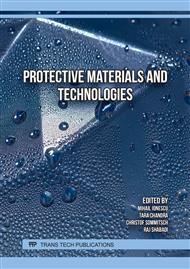[1]
S. Ishino, T. Kondo, M. Okada, Journal of Nuclear Materials 179-181 (1991) 3-8.
Google Scholar
[2]
T. Muroga, Y. Hatano, D. Clark, Y. Katoh, Journal of Nuclear Materials 560 (2022) 153494.
Google Scholar
[3]
M. Kiritani et al., Journal of Nuclear Materials 174 (1990) 327-351.
Google Scholar
[4]
N. Yoshida et al., Journal of Nuclear Materials 179-181 (1991) 1078-1082.
Google Scholar
[5]
H. Watanabe, T. Muroga, N. Yoshida, Journal of Nuclear Materials 217 (1994) 178-186.
Google Scholar
[6]
A.L. Qualls, T. Muroga, Journal of Nuclear Materials 258-263 (1998) 407-412.
Google Scholar
[7]
H. Watanabe, T. Muroga, N. Yoshida, Journal of Nuclear Materials 307-311 (2002) 403-407.
Google Scholar
[8]
B.A. Loomis, S.B. Gerber, A. Taylor, Journal of Nuclear Materials 68 (1977) 19-31.
Google Scholar
[9]
H.L. Heinisch, B.N. Singh, Journal of Nuclear Materials 307-311 (2002) 876-880.
Google Scholar
[10]
T. Muroga et al., Fusion Science and Technology 44 (2003) 450-454.
Google Scholar
[11]
T. Muroga, Y. Nonaka, N. Yoshida, Journal of Nuclear Materials 233-237 (1996) 1035-1039.
Google Scholar
[12]
B.L. Eyre, R. Bullough, Philosophical Magazine 12 (1965) 31-39.
Google Scholar
[13]
Z. Yao et.al., Philosophical Magazine 90 (2010) 4623-4634.
Google Scholar
[14]
Y. Dai et al. Journal of Nuclear Materials 15 (2011) 306-310.
Google Scholar
[15]
Y. Dai, G.S. Bauer, Journal of Nuclear Materials 296 (2001) 43-53.
Google Scholar
[16]
e.g., G.S. Was, Fundamentals of Radiation Materials Science, Springer (2007) Chapter 11.
Google Scholar
[17]
T. Okita et al., Journal of Nuclear Materials 307-311 (2002) 322-326.
Google Scholar
[18]
N.H. Packan, K. Farrell, J.O. Stiegler, Journal of Nuclear Materials 78 (1978) 143-155.
Google Scholar
[19]
T. Muroga, H. Watanabe, N. Yoshida, Journal of Nuclear Materials 174 (1990) 282-288.
Google Scholar
[20]
T. Muroga et al., Plasma and Fusion Research 11 (2016) 2405007.
Google Scholar
[21]
S. Yanagita et al., Materials Transactions 43 (2002) 1663-1669.
Google Scholar
[22]
T. Muroga, H. Tanigawa, Fusion Science and Technology 72 (2017) 389-397.
Google Scholar
[23]
M. Narui, T. Sagawa, T. Shikama, Journal of Nuclear Materials 258-263 (1998) 372-377.
Google Scholar
[24]
B. Rossaert et al., Journal of Nuclear Materials 565 (2022) 153742.
Google Scholar
[25]
T. Muroga, S. Fukada, T. Hayashi, Fusion Science and Technology 75 (2019) 559-574.
Google Scholar
[26]
A. Ibarra et al., Nuclear Fusion 59 (2019) 065002.
Google Scholar
[27]
K. Ochiai et al., Nuclear Fusion 61 (2021) 025001.
Google Scholar
[28]
T. Muroga, A. Möslang, E. Diegele, Journal of Nuclear Materials 535 (2020) 152186.
Google Scholar



